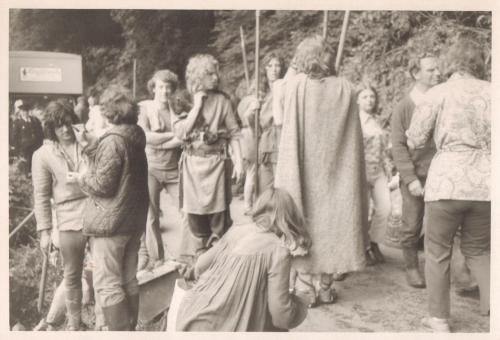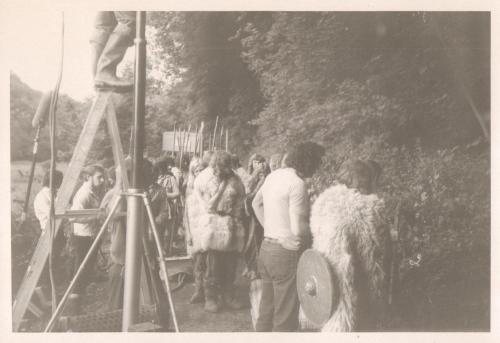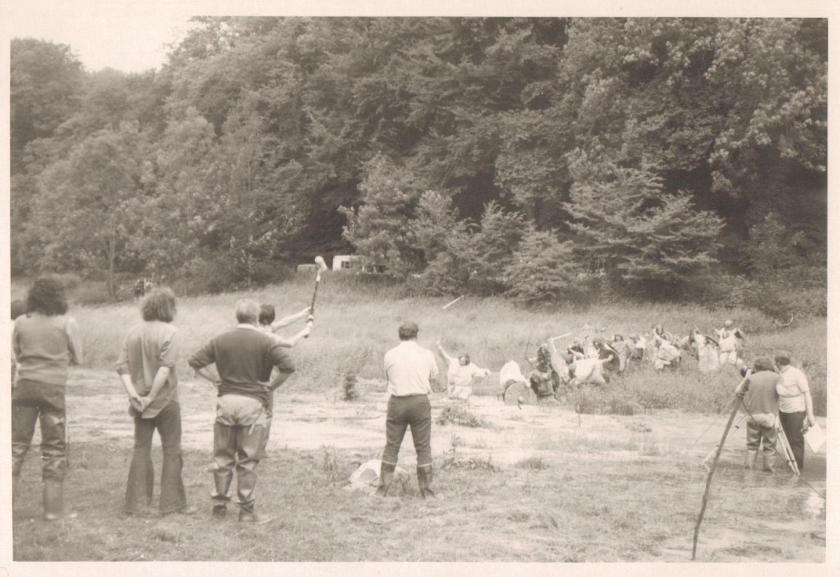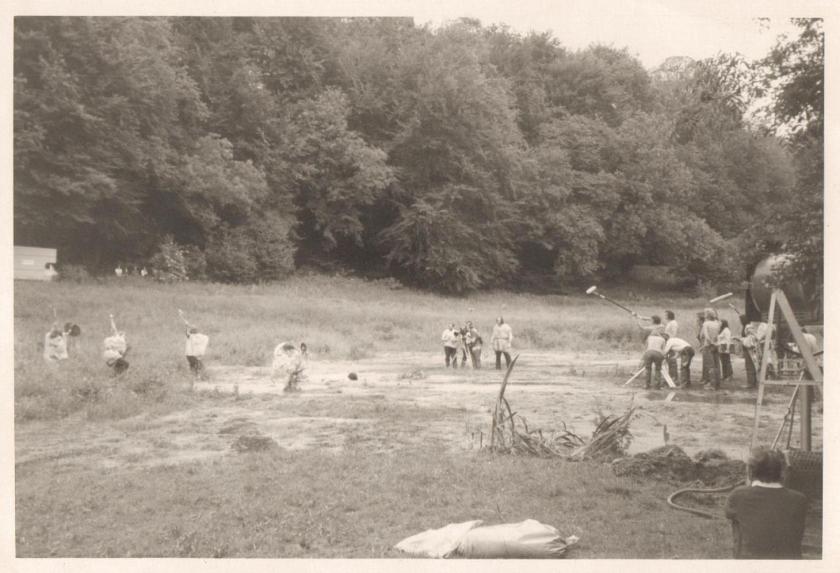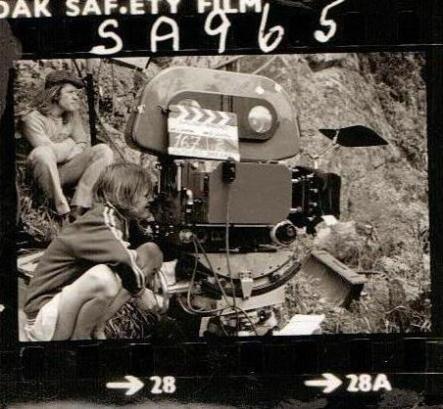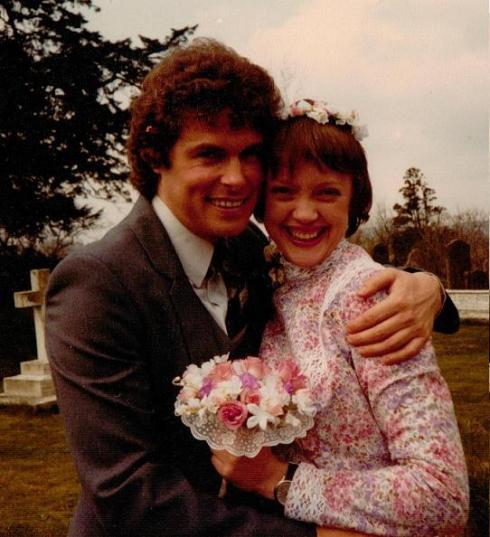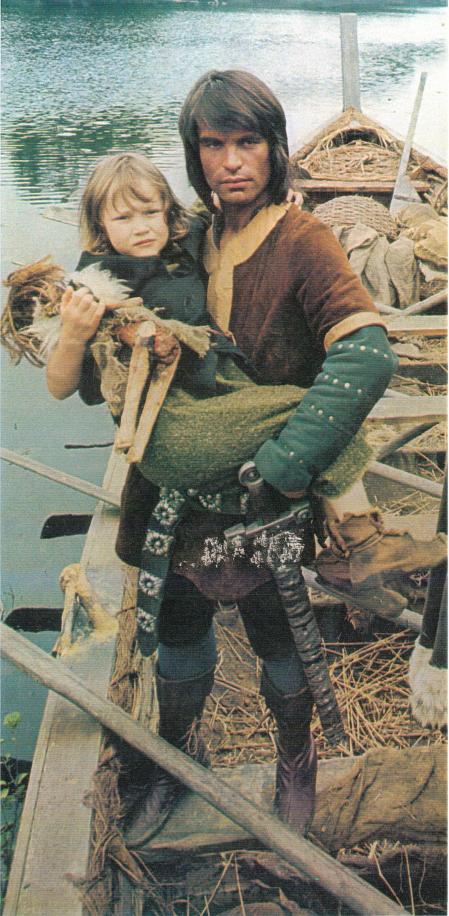I have been writing about my experiences behind-the-scenes in film and television. There is one series in particular that still has a strong following, particularly those interested in British medieval history.
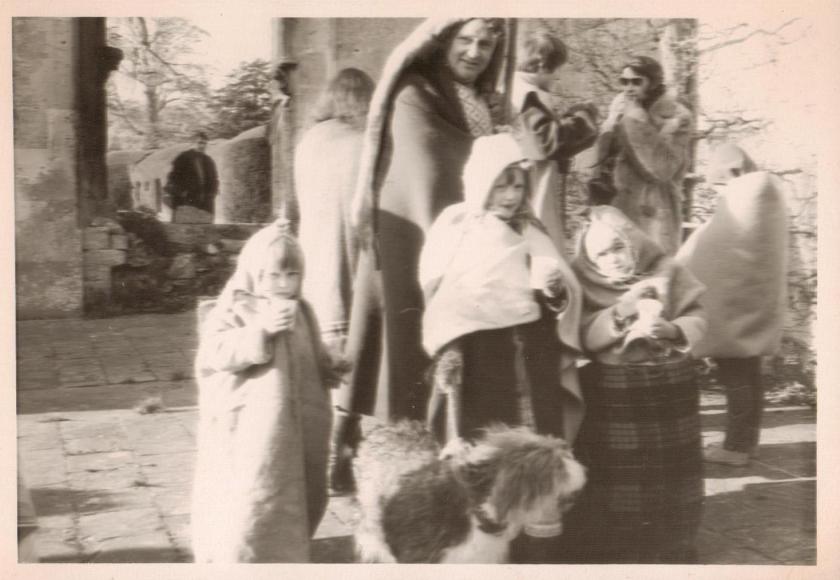
As children, back in 1971, we were all excited to hear that HTV was planning to film a series about King Arthur near where we lived in Gloucestershire. We were keen on dressing up and I was already interested in medieval history.
The Arthurian legend had always been portrayed with ladies in pointy conical hats and knights in chain mail riding around with lances, however expectations of turreted castles were soon to be dashed.
We woke up one morning to find this tent in the field beyond our house, with a full English breakfast being served by location caterers from the back of a two-tone bus. The final scenes of Episode One of the series Arthur of the Britons, entitled Arthur is Dead, starring Oliver Tobias in the title role, was to be filmed on our farm.

We learnt that the drama series, Arthur of the Britions was to be quite different from traditional renditions of the well-loved stories. Apart from anything else the actors had long hair and wore rough hessian garments or sheepskins to reflect the culture of Iron Age England. Everyone was excited about the idea, which seemed more authentic and certainly held more sex-appeal than the Hollywood idyl lodged in our consciousness.
While the lane below the wood that ran along the sides of our valley was closed to traffic, HTV ran cables and moved in with their lights, camera equipment and props amounting to bundles of swords, spears, shields and other weaponry.
Here you can see the Gulliver’s Prop lorry as well as costume and make-up artists with their kit-bags attending to the actors and supporting artistes. Please remind me of the name of the character to the left of shot and who played him. ***
It must have been dark under the trees, as there would have been have been a large 2K light on this tripod. The crew set up carefully and were finally ready to go for a take, recording the battle in the woods on 16mm.
After a short skirmish, Arthur pretends to retreat, leading his men downhill. They are soon followed by the Saxon hordes. The reality was that the wood was much steeper than it came across on television. The actors ended up tumbling down the bank.
We were waiting in the open field in the valley floor. Although naturally marshy, this had been made much wetter by damming the stream that flowed down from the woods. Our local road engineer Percy Baxter dug pits that filled with water and acted as a trap for the Saxons who did not know the secret way through the marshes.
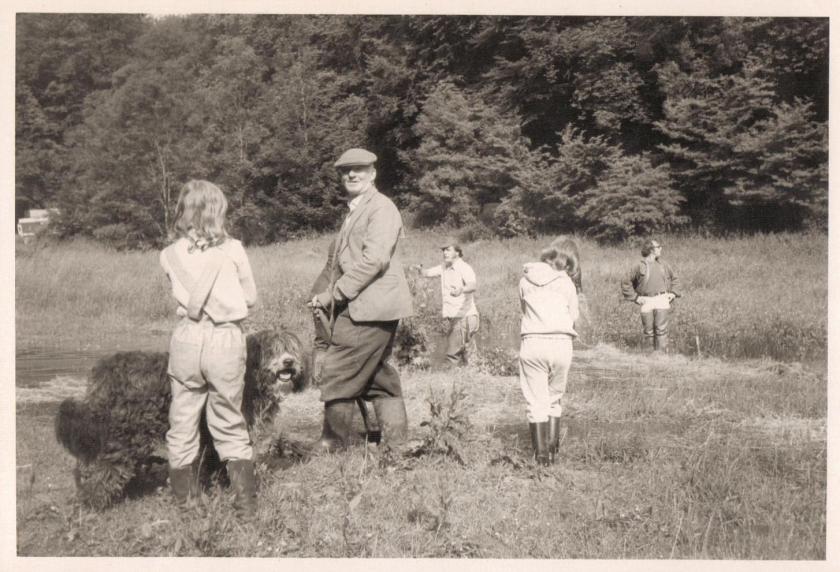
We knew of the legend and were fascinated to see how the sequence would come together.
As the scene was difficult to replicate it was shot with two cameras, seen here set on wooden tripods. The result was exciting.
For photos of the location on the Arthur of the Britons website please click here.
Scroll to 19.50 towards the end of the episode to watch the scene here on Youtube:
***Post script: This email arrived recently. I have been given permission to feature it:
“Browsing the web the other day, I came across your website and photos relating to filming ‘Arthur of the Britons’. One photo in particular interested me, the one in which the request, ‘Please remind me of the name of the character to the left of shot and who played him’ appears.
Looking at that photo stirred many memories…
Back in 60’s Bristol, my old chum Bob Baker was trying his hand at script-writing for the media, somehow he got involved with a BBC Children’s series entitled ‘Pegasus’: of which meager entries appear online and actual footage seems non existent.
Bob and I enlisted as extras for a shoot at Berkeley Castle, much fun, beautifully authentic Napoleonic Infantry costumes, several closeups, a hard in-character slap on the face for Bob and a shot of me firing a rifle at an imaginary ‘Pegasus’, the eponymous hot air balloon, as it took off from the castle courtyard carrying the escapee heroes of the plot. An excellent tight closeup only marred by myself who, having fired and watched the imaginary effect of my bullet, lowered the rifle and stared up intently, for what seemed minutes (at nothing) finally relaxed… as my eye was drawn inexorably towards the huge camera lens inches from my face. ‘Christ! He just looked straight into the camera! Cut!’ I was particularly stung by a co-extras unconcealed schadenfreude as he muttered, ‘Shame about that Rog, they liked the look of you, blown your chances now.’ But it was too good to waste and, edited, made it into the final cut: it was however the last close-up I got.
The final location work called for a night shoot, it was raining intermittently and shooting was sporadic, Bob and I spent most of the night in the canteen, drinking wine with our old mate Keith Floyd who had managed to land the catering job – in many ways, the start of his career and of course he went on to considerable success, fame and several television series of his own. Bob and I ran out of cigarettes so, fully accoutered and armed with cocked hats, swords, rifles and bayonets, we strolled down into Berkeley village and went into The Boar’s Head just at closing time, startling the small group of locals, and ordered two pints and some fags. A stunned silence descended as without a word, Bob and I drained our pints and left as suddenly as we had appeared. I wonder if the legend of the two thirsty apparitions from La Grande Armée is told there still?
Bob and co-writer Dave Martin had written a well-researched film script about King Arthur. They knocked on many doors, Hollywood was mentioned; even Charlton Heston was reported to be interested, but finally, in 1973, it was HTV who eventually picked it up, though I see Bob actually gets credit only for the first episode ‘People of the Plough’. Of course, he went on to write many of the scripts for ‘Dr Who’ and ‘Wallace and Grommit’ but this was his first, if modest, success.
I was on my summer vacation and Bob mentioned HTV were looking for extras for ‘Arthur’ if I was interested. When I arrived on set it seemed that half of Bristol was there including many of my drinking mates from Clifton, most of whom had arrived equipped with cider and beer and it became fairly apparent the direction things would take. A few years ago I was reminiscing about those days with one of them, Mike Dauncey, who went on to become a respected BBC Cameraman, but who sadly, recently died. He told me he spent most of his time in the actors tent, along with a few other reprobates, smoking pot. I recall seeing him at the time but had no idea what was going on, though I remember enjoying plenty of the extraordinary amounts of alcohol that seemed to be around. I’m pretty sure Mike is the guy in the patterned doublet with his back to the camera, extreme right.
Vaguely, I recall lots of nonsense, involving charging down hills waving swords and yelling, mock fighting in in the river and defending a primitive ‘Saxon Village’ that had been constructed on a river bank. As always, shooting was a bit piecemeal, scenes being shot out of sequence and us extras standing around as background whilst Oliver Tobias, Jack Watson and, by the end of the shoot, the Celts, had taken the village. Not terribly dramatic at the time, presumably any attendant pillage and rapine was the subject of a different shoot, though I recall a fair amount of fake blood waiting in readiness. Finally the script called for the Celts to set fire to the village. And thus I got my big starring role, as employing all my acting skills, dressed in a ‘bloody’ sheepskin and in closeup, I was required to play a dead Saxon.
Unfortunately it had been steadily raining all day and the ‘village’, built largely from straw and dummy plastic wickerwork, refused to ignite. I was lying very close to the ‘village’ and began to get a bit concerned as, from my worms eye view, I watched the crew enthusiastically chucking gallons of petrol over the village to get things going. It all seemed to take a long time and as I lay there in the rain, I remember hoping they hadn’t forgotten that the dead Saxon was actually an extra and not a prop. More time went by setting up the shots but eventually the scene was in readiness. Action! shouted the director and with cameras rolling, three ‘Celtic horsemen’ with flaming torches galloped down on the village, narrowly avoiding trampling me, threw the torches at the ‘buildings’ and galloped off. For several seconds nothing happened, then suddenly with a huge WHOOMPH! all that petrol just went off, The heat where I was lying was incredible, the grass between me and the village began to steam then turn yellow and smoke, I began to smell wet, then burning wool, as my sheepskin began to smoulder, fortunately too sodden and thick to actually catch fire, but lying there, I discovered an earnest empathy for those Guy Fawkes dummies I had chucked on bonfires as a kid. The crew were oblivious to my plight as the director called for several takes and the scene took over an hour to shoot until eventually the flames died down and a wrap was called.
Months later the series appeared on TV, I saw very little of it but did see that scene; by modern standards it looked fairly amateurish, obviously phoney as you could see the plastic ‘wickerwork’ melting, but my closeup was excellent, I looked just like a corpse, very realistic, despite gently steaming.
Bob and Dave Martin always referred to the series as ‘Arthur in The Stinging Nettles’ but what struck me about that photo is that it looks more like the set for some fey setting of Lothlórien. What a bunch of fairies!
So back to that plea, who was the character on the left? Well, if it’s the guy having his face touched-up on the extreme left, I’m afraid it was no actor, just an extra that played a corpse. Me.
I seem to have banged on a bit, strange how a photograph brings it all back, apologies if it just seems like some old blokes boring memories – but then again, that’s exactly what it is!
Best regards,
Roger Harding”


